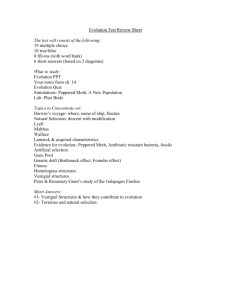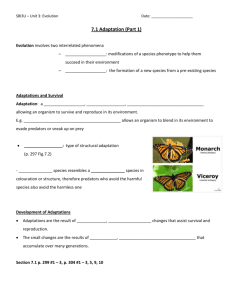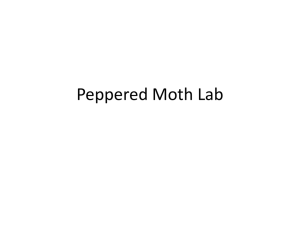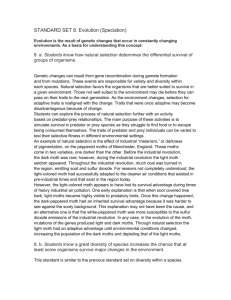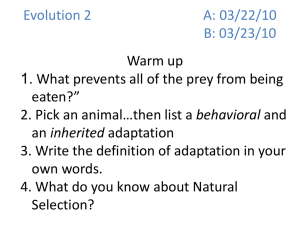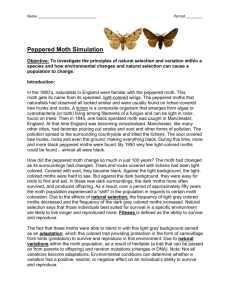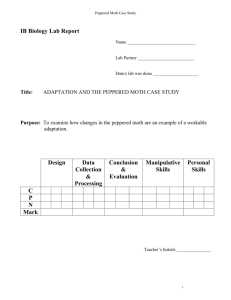Student Exploration Sheet: Growing Plants
advertisement
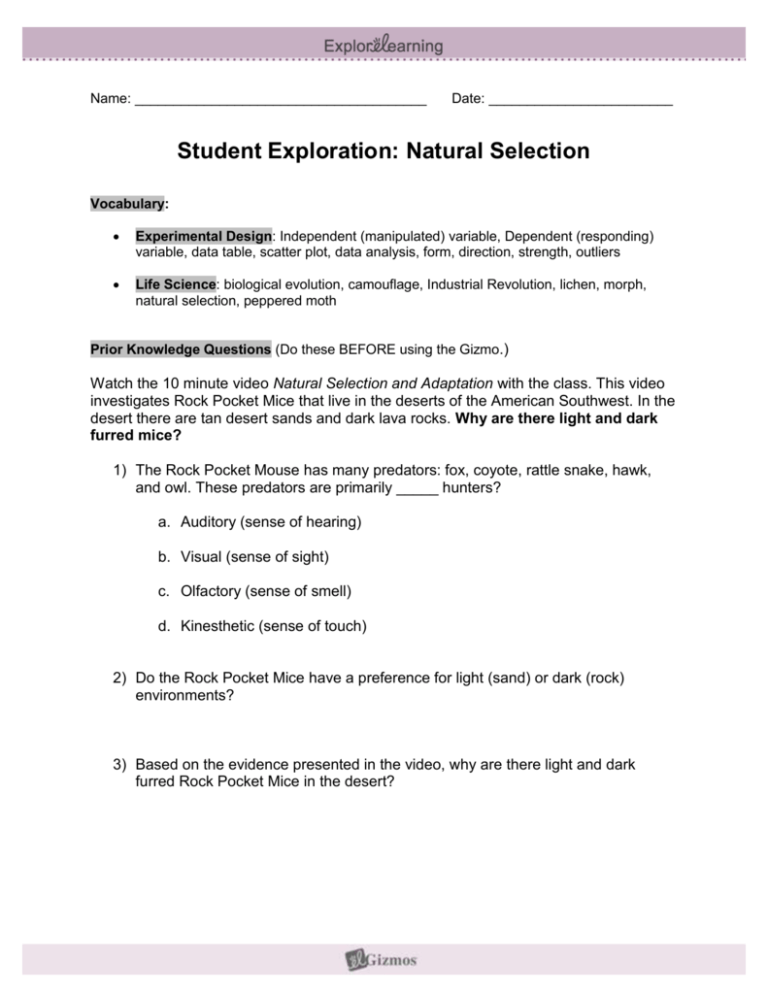
Name: ______________________________________ Date: ________________________ Student Exploration: Natural Selection Vocabulary: Experimental Design: Independent (manipulated) variable, Dependent (responding) variable, data table, scatter plot, data analysis, form, direction, strength, outliers Life Science: biological evolution, camouflage, Industrial Revolution, lichen, morph, natural selection, peppered moth Prior Knowledge Questions (Do these BEFORE using the Gizmo.) Watch the 10 minute video Natural Selection and Adaptation with the class. This video investigates Rock Pocket Mice that live in the deserts of the American Southwest. In the desert there are tan desert sands and dark lava rocks. Why are there light and dark furred mice? 1) The Rock Pocket Mouse has many predators: fox, coyote, rattle snake, hawk, and owl. These predators are primarily _____ hunters? a. Auditory (sense of hearing) b. Visual (sense of sight) c. Olfactory (sense of smell) d. Kinesthetic (sense of touch) 2) Do the Rock Pocket Mice have a preference for light (sand) or dark (rock) environments? 3) Based on the evidence presented in the video, why are there light and dark furred Rock Pocket Mice in the desert? The Peppered Moth (Biston betularia) is a common moth found in Europe, Asia, and North America. It is commonly found in two forms, or morphs: a dark morph and a light, speckled morph. Birds are a frequent predator of the peppered moth. 2) 4) Which morph do you think would be easier to see on a dark tree trunk? 4) 5) Which morph do you think would be easier to see on a light tree trunk? You are going to simulate performing an experiment with the Peppered Moth. Your investigative question is: How does the color of a Peppered Moth affect survival? 6) What is the independent (manipulated) variable in this experiment? 7) What is the dependent (responding) variable in this experiment? 8) Hypothesis: Do you think the color of a Peppered Moth will affect survival? Be sure to support your hypothesis with reasoning. Gizmo Instructions The Natural Selection Gizmo™ allows you to play the role of a bird feeding on peppered moths. The initial population of 40 moths is scattered over 20 tree trunks. Click on moths to capture them. Click the Start button to start Click the Next tree button or hit the spacebar on your keyboard to advance to the next tree. Activity A: Light trees Get the Gizmo ready: Click Reset. Check that the LIGHT TREES tab is selected. Introduction: Before the 19th century in England, the air was very clean. The bark on trees was usually light in color. Abundant lichens growing on tree trunks also lightened their appearance. Question: How does the color of a peppered moth affect survival? 1. Predict: Camouflage is coloring or patterns that help an organism to blend in with the background. Over time, what will to happen to the populations of light and dark moths on light trees? 2. Experiment: Click Start and hunt peppered moths on light tree trunks for five years. In each year, try to capture as many moths as you can. (Hint: Use the spacebar on your keyboard to advance to the next tree.) 3. Data Analysis: After 5 years, select the GRAPH tab. This is a scatter plot to determine if there is a relationship between Pepper Moth color and survival. Please provide the summary for this graph. Is there a relationship between color and survival? If so, please describe the form, direction, and strength of the relationship. Are there any outliers? Be sure to provide evidence (data) to support your claim. This graph shows . . . Activity B: Dark trees Get the Gizmo ready: Click Reset. Select the DARK TREES tab. Introduction: The 19th century was the time of the Industrial Revolution in England. Most of the new industries used coal for energy, and the air was polluted with black soot. In forests near factories, the soot coated trees and killed lichens. As a result, tree trunks became darker. Question: How does the color of a peppered moth affect survival? 1. Predict: Over time, what will to happen to the populations of light and dark moths on dark trees? 2. Experiment: Click Start and hunt peppered moths on dark tree trunks for five years. In each year, try to capture as many moths as you can. (Hint: You can use the spacebar on your keyboard to advance to the next tree.) 3. Data Analysis: After 5 years, select the GRAPH tab. This is a scatter plot to determine if there is a relationship between Pepper Moth color and survival. Please provide the summary for this graph. Is there a relationship between color and survival? If so, please describe the form, direction, and strength of the relationship. Are there any outliers? Be sure to provide evidence (data) to support your claim. This graph shows . . . Think Like A Scientist: 4. Apply: Which type (morph) of moth was more common before the 19th century? Which type (morph) of moth was more common after the 19th century? Why? 5. Draw conclusions: Natural selection is the process by which favorable traits tend to increase in frequency over time. How does this experiment illustrate natural selection? 6. Think and discuss: Did the changes you observed in the moth populations result from individual moths changing colors? Or did they occur because the best-hidden moths survived and reproduced, passing on their colors to their offspring? Explain your answer. 7. Extend your thinking: Biological evolution is the process by which populations of organisms change over time. How could natural selection lead to evolution? If possible, discuss your answer with your classmates and teacher.



